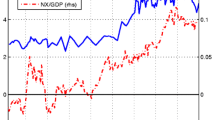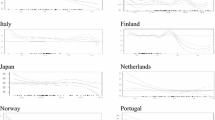Abstract
The design of monetary system in Slovenia was influenced by the heritage of peristent shortages of foreign exchange. This and other considerations prompted a decision that a new currncy-Tolar was to float on two separate foreign exchange markets: a market for current account transactios, and a market for capital account transactios. Actual developments differed considerably from forecasts; an abundance prevailed, and the Tolar remained remarkably strong. The aim of the paper is to present, estimate and test a simple model describing the behaviour of the Tolar in the first period of high uncertainty; and to assess its relevance for the real world. Exchange-rate movements are analyzed as if they were adjusting to the expected price level. The results imply that the dealers do not wait for new data on prices to be disclosed; they, howevr, try and anticipate the likely effects of inflation on the exchange rate. It is shown that interventions by the Central Bank did not affect the SIT/DM exchange rate appreciably. The answer to the question whether other Eastern European countries could have benefitted from “the short-run story of the tolar’, is inconclusive, if not negative.
Similar content being viewed by others
References
Aghevli, B.B. et al. (1991) ‘Exchange Rate Poolicy in Developing Countries: Some Analytical Issue’,IMF Occasional Papers, 78.
Bomhoff, E. (1992) Monetary Reform in Eastem Europe.European Economic Review,36(2/3), 454–458.
Collier, P. and Joshi, V. (1989) ‘Exchange Rate Policy in Developing Countries’.Oxford Review of Economic Policy,5(3), 94–113.
Corbo, V. (1992) ‘Economic Transformation in Latin America: Lessons from Easterm Europe’,European Economic Review,36(2/3), 407–416.
Dervis, K., De Melo, J., and Robinson, S. (1982)General Equilibrium Models for Development Policy, Cambridge University Press.
Dornbusch, R. (1992) ‘Monetary Problems of Post-Communism: Lessons from the End of the Austro-Hungarian Empire.Weltwirtschaftliches Archiv,3(128), 391–424
Granger, C. and Newbold, P. (1974) ‘Spurious Regression in Econometrics’,Journal of Econometrics.
MacDonald, R. and Taylor,M. (1992) ‘Exchange Rate Economics’,IMF Staff Papers,39(1), 1–57.
Meltzer, A.H. (1992) ‘Prices and Wages in Transition to a Market Economy’,unpublished, presented at the 19th Karl Brunner Symposium on Liberty, Analysis, and Ideology, Interlaken, Switzerland, June 8–12, 1992.
Mencinger, J. (1993) ‘How to Create a Currency?-The Experience of Slovenia,Weltwirtschaftliches Archiv,129(2), 418–431.
Pesaran, M.H., and Pesaran, B. (1991)Microfit 3.0., Oxford University Press, 1991.
Stock, J., and Watson, M. (1988) ‘Variable Trends in Economic Time Series’Journal of Economic Perspectives,2(3), 147–174.
Author information
Authors and Affiliations
Additional information
We are grateful to A. Beltratti, A. Brzeski, Ch. Flinn, P. Sgro, H. Wagener and the referees of this Journal for their comments on a preliminary draft of this paper. Part of this work has been carried out while J. Mencinger was a Fellow at ICER, Turin, to which we are both indebted.
Rights and permissions
About this article
Cite this article
Colombatto, E., Mencinger, J. Partial adjustment without tears: A tale for the tolar. Empirica 22, 83–101 (1995). https://doi.org/10.1007/BF01384647
Issue Date:
DOI: https://doi.org/10.1007/BF01384647




